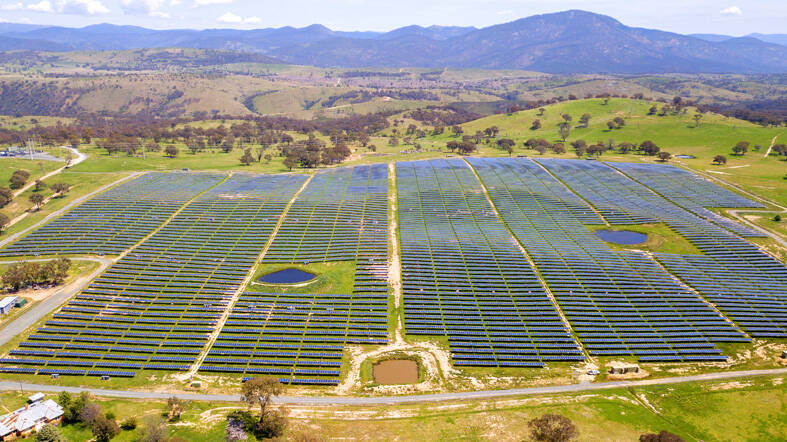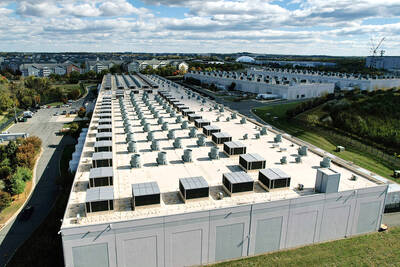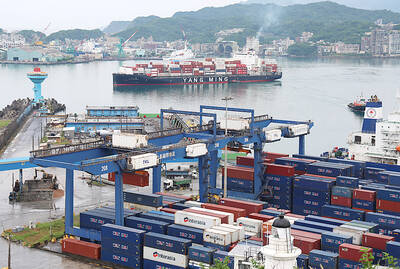Australia yesterday approved plans for a massive solar and battery farm that would export energy to Singapore, a project billed as the “largest solar precinct in the world.”
Authorities announced environmental approvals for Sun Cable Pty Ltd’s US$24 billion project in Australia’s remote north that is slated to power three million homes.
The project, which will include an array of panels, batteries and, eventually, a cable linking Australia with Singapore, is backed by tech billionaire and green activist Mike Cannon-Brookes.

Photo: AAP via AP
“It will be the largest solar precinct in the world — and heralds Australia as the world leader in green energy,” Australian Minister for the Environment and Water Tanya Plibersek said.
It is hoped that energy production will begin in 2030, providing four gigawatts of energy for domestic use.
Two more gigawatts would be sent to Singapore via undersea cable, supplying about 15 percent of the city-state’s needs.
Sun Cable Australia’s managing director Cameron Garnsworthy said the approval was “a landmark moment in the project’s journey.”
Numerous approval processes and other hurdles remain despite yesterday’s green light.
The project depends on sign-offs from Singapore’s energy market authority, Indonesia’s government and Australian Indigenous communities.
Singapore’s Energy Market Authority said in a statement that it was in “discussions with Sun Cable on its proposal for electricity imports into Singapore” but did not provide further details.
Garnsworthy said: “Sun Cable will now focus its efforts on the next stage of planning to advance the project toward a final investment decision targeted by 2027.”
Countries around the world are racing to bring major solar projects online to ease the transition away from polluting fossil fuels.
China leads the way and is building almost twice as much wind and solar capacity as every other country combined.
It brought the 3.5 gigawatt Midong solar farm online this year, its largest facility so far.
In contrast, Australia remains one of the world’s leading exporters of coal and gas, despite being ravaged by the effects of climate change from intense heat to floods and bushfires.
Although Australians are among the world’s most enthusiastic adopters of household solar panels, a string of governments have been hesitant to embrace renewables.
Renewables made up 32 percent of Australia’s total electricity generation in 2022 compared to coal, which contributed 47 percent, according to the latest government data.
Plibersek hailed the project as a way of meeting Australia’s projected energy shortfall and creating “14,300 new jobs in northern Australia.”
Ken Baldwin, director of the Energy Change Institute at the Australian National University, said the project was a “world first” for exporting renewable electricity from solar and wind on such a scale.
“Australia has some of the best solar and wind resources of any country and, as a result, is installing solar and wind at one of the fastest rates of any country in the world on a per capita basis,” he told AFP.
This momentum must continue, Baldwin said, particularly if Australia is to meet its net zero targets by 2050.
“Australia has, over the last five years, invested heavily in solar and wind, but it needs to double and triple that investment in order to reach its climate trajectory towards a net zero future by 2050.”
He said Australia will need about 100 gigawatts of solar and wind capacity by the 2030s. The Sun Cable project will only provide four gigawatts of that need.
Climate Council chief executive Amanda McKenzie said the new solar hub was a bold step in making Australia a “clean energy powerhouse” and that such projects were essential in “delivering affordable energy and slashing climate pollution.”
“With the closure of coal-fired power stations on the horizon, Australia needs to accelerate the roll-out of solar and storage at every level — rooftops, large-scale projects and everything in between,” she said.
The project would also be a significant step for Cannon-Brookes, who once described the project as “insane” before becoming an enthusiastic investor.

The demise of the coal industry left the US’ Appalachian region in tatters, with lost jobs, spoiled water and countless kilometers of abandoned underground mines. Now entrepreneurs are eyeing the rural region with ambitious visions to rebuild its economy by converting old mines into solar power systems and data centers that could help fuel the increasing power demands of the artificial intelligence (AI) boom. One such project is underway by a non-profit team calling itself Energy DELTA (Discovery, Education, Learning and Technology Accelerator) Lab, which is looking to develop energy sources on about 26,305 hectares of old coal land in

Taiwan’s exports soared 56 percent year-on-year to an all-time high of US$64.05 billion last month, propelled by surging global demand for artificial intelligence (AI), high-performance computing and cloud service infrastructure, the Ministry of Finance said yesterday. Department of Statistics Director-General Beatrice Tsai (蔡美娜) called the figure an unexpected upside surprise, citing a wave of technology orders from overseas customers alongside the usual year-end shopping season for technology products. Growth is likely to remain strong this month, she said, projecting a 40 percent to 45 percent expansion on an annual basis. The outperformance could prompt the Directorate-General of Budget, Accounting and

Netflix on Friday faced fierce criticism over its blockbuster deal to acquire Warner Bros Discovery. The streaming giant is already viewed as a pariah in some Hollywood circles, largely due to its reluctance to release content in theaters and its disruption of traditional industry practices. As Netflix emerged as the likely winning bidder for Warner Bros — the studio behind Casablanca, the Harry Potter movies and Friends — Hollywood’s elite launched an aggressive campaign against the acquisition. Titanic director James Cameron called the buyout a “disaster,” while a group of prominent producers are lobbying US Congress to oppose the deal,

Two Chinese chipmakers are attracting strong retail investor demand, buoyed by industry peer Moore Threads Technology Co’s (摩爾線程) stellar debut. The retail portion of MetaX Integrated Circuits (Shanghai) Co’s (上海沐曦) upcoming initial public offering (IPO) was 2,986 times oversubscribed on Friday, according to a filing. Meanwhile, Beijing Onmicro Electronics Co (北京昂瑞微), which makes radio frequency chips, was 2,899 times oversubscribed on Friday, its filing showed. The bids coincided with Moore Threads’ trading debut, which surged 425 percent on Friday after raising 8 billion yuan (US$1.13 billion) on bets that the company could emerge as a viable local competitor to Nvidia